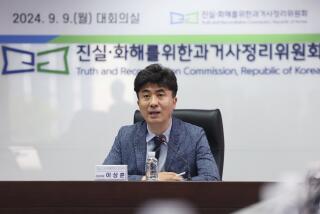Report: S. Korean Created No Human Stem Cells
- Share via
SEOUL — The South Korean university that sponsored what was hailed around the world as groundbreaking cloning research said today that its scientists never created a single human embryo clone or resulting human stem cell.
In its final report, an investigative committee at Seoul National University found that Hwang Woo Suk had fabricated and manipulated evidence in all of his published papers on human cloning. The panel said, however, that the veterinarian had better luck with dogs and that last year’s cloning of Snuppy, an Afghan hound, appeared genuine.
In December, the university found fabrications in a 2005 report in which Hwang claimed to have created 11 customized stem-cell lines using DNA from sick and disabled patients. But until now, scientists had hoped that a 2004 paper in which he reported the creation of the first human embryo clone would prove to be legitimate.
Instead, the investigation has forced researchers to confront the fact that two years of supposed progress were suddenly wiped away.
Hwang’s team “deceived the scientific community and the general public,” said Chung Myung Hee, a professor of medicine, grimly reading the results of the nine-member panel’s inquiry.
He said the university was considering severe disciplinary measures against 40 people involved in the fabrications, including Hwang.
The 53-year-old scientist told reporters last month that he was in the process of thawing frozen samples that would prove his claim of having produced human stem cells from cloned embryos. But he has yet to do so and is believed to be in seclusion in a Buddhist monastery.
Hwang’s work had raised the dramatic possibility that tailor-made tissues could be produced for patients suffering from spinal cord injuries and genetic diseases such as Alzheimer’s, Parkinson’s and juvenile diabetes. From around the world, patients flocked to Hwang’s laboratory, and women throughout South Korea donated eggs to support his research.
“It all turned out to have been a pipe dream,” said Dr. Arnold Kriegstein, director of the Institute for Stem Cell and Tissue Biology at UC San Francisco.
When Hwang’s 2004 study was published, it was instantly seen as a milestone in the effort to heal patients suffering from otherwise incurable conditions. The breakthrough made front-page news around the globe and rocketed Hwang to national stardom.
In the paper, Hwang’s team said it had created human embryo clones by removing the DNA from healthy eggs and replacing it with genetic material from another type of cell called a cumulus cell. In each case, the egg and the cumulus cell were taken from the same patient. After several days, according to the paper, one of the embryos was used to create a line of embryonic stem cells, which are prized for their apparent ability to produce any kind of cell in the human body.
The university said in its report that the embryo created was probably not cloned but the result of a process called parthenogenesis, in which an egg spontaneously divides. The creation of a four- or five-day embryo from such a process would not be considered a notable scientific achievement, according to scientists. The 2004 report, published in the U.S. journal Science, included the caveat that the embryo could be a parthenote, not a clone, but said it was unlikely.
More serious problems were found in the 2005 paper in which Hwang described creation of 11 stem cell lines using DNA from sick and injured patients, both male and female. Now, the university says the stem cells were probably regular embryonic stem cells created from fertilized eggs.
The university also uncovered a thicket of lies.
For example, Hwang distributed a questionnaire to female graduate students asking if they would donate eggs to his research and then denied having any knowledge of it, according to the report. International ethical standards prohibit scientists from asking researchers for such donations. Hwang also apparently lied about his efficiency in cloning, claiming for his 2005 report that he had used 185 eggs, but the investigators believed that more than 1,000 were used.
As far as animal cloning is concerned, Hwang appears to have had greater success. The university reported that the 9-month-old Afghan puppy known as Snuppy -- for “Seoul National University puppy” -- was in fact cloned from a 3-year-old male Afghan. Some critics had raised the possibility that the original and the purported clone were identical twins, but genetic testing of both dogs, as well as a surrogate mother, supported the assertion that the descendant was a clone.
“There is something for us to be proud of as Koreans. It is very difficult to clone animals, especially dogs. I am happy to announce that this dog is a real clone,” said Rhee Seung Jae, a Seoul-based geneticist who was one of several experts asked to test the dogs.
Even now Hwang has many supporters. Demonstrators held placards defending him at the university today and lined walkways with pink streamers in a show of support.
But amid all the enthusiasm surrounding the 2004 paper, there were some early questions.
Dr. Robert Lanza, medical director of Advanced Cell Technology in Worcester, Mass., for one, was skeptical about some of the chemicals Hwang claimed he had used in the cloning process. Based on work done by scientists at his company, he believed those chemicals were too strong and would have destroyed the eggs.
He also doubted Hwang’s claim that one of the crucial steps was using a squeezing method to remove the nucleus from the egg. That technique works in animals because the nucleus is close to the egg’s surface. But in human eggs, the nucleus is in the center, and squeezing it out would have removed crucial cellular components that are necessary to prompt an egg to divide and grow, Lanza said.
“I called for a third-party investigation right after that paper, but it fell on deaf ears,” he said.
Stem cell researchers remain confident that therapeutic cloning would become a reality.
“It will eventually be possible to create stem cell lines in humans using this technique,” Kriegstein said. “It’s been possible in other mammalian species, and there isn’t a theoretical reason why it shouldn’t also be possible in primates.”
The main reason it hasn’t been accomplished is that human eggs are in short supply and the Bush administration prohibits federal funding for this line of research, Kriegstein said.
Scientists at Advanced Cell are planning to resume the cloning work that was abruptly halted after the publication of the 2004 paper, Lanza said.
By late 2003, they were on the verge of getting their cloned embryos to develop to what is called the blastocyst stage, when they could be used to create stem cells, he said. After the South Korean breakthrough was announced, the in-vitro fertilization clinic that had been providing eggs for the company’s research cut off its supply because the feat had purportedly been achieved.
“My chief scientist said to me, ‘If you get me one more round of eggs, I guarantee you I’ll get stem cells,’ ” Lanza said. “We would have published sometime in early 2004 or maybe mid-2004.”
Now Lanza’s company is close to procuring a new supply of eggs for its research, he said. Once they are in hand, “we’ll have cloned blastocysts hopefully in a week, and the first stem cells a few more weeks after that,” he said. “We’re ready to go.”
Demick reported from Seoul and Kaplan from Los Angeles.
More to Read
Sign up for Essential California
The most important California stories and recommendations in your inbox every morning.
You may occasionally receive promotional content from the Los Angeles Times.











